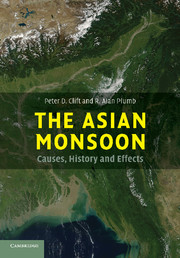Book contents
- Frontmatter
- Contents
- Preface
- Acknowledgements
- 1 The meteorology of monsoons
- 2 Controls on the Asian monsoon over tectonic timescales
- 3 Monsoon evolution on tectonic timescales
- 4 Monsoon evolution on orbital timescales
- 5 Erosional impact of the Asian monsoon
- 6 The Late Holocene monsoon and human society
- References
- Further reading
- Index
- Plate section
6 - The Late Holocene monsoon and human society
Published online by Cambridge University Press: 01 September 2009
- Frontmatter
- Contents
- Preface
- Acknowledgements
- 1 The meteorology of monsoons
- 2 Controls on the Asian monsoon over tectonic timescales
- 3 Monsoon evolution on tectonic timescales
- 4 Monsoon evolution on orbital timescales
- 5 Erosional impact of the Asian monsoon
- 6 The Late Holocene monsoon and human society
- References
- Further reading
- Index
- Plate section
Summary
Introduction
Two-thirds of the world's population depend on the Asian monsoon to bring much needed moisture for agriculture and drinking water, the basic needs underpinning society. However, the yearly rains can also bring peril. Floodwaters triggered by summer monsoon rain often kill hundreds, sometimes thousands, of people in China, India, Nepal, Bangladesh and throughout Indochina, displacing millions of others. The high population density and corresponding competition for fertile agricultural land and water resources means that the summer monsoon rains are central to continued economic and cultural development of South and East Asia. Future changes in monsoon intensity will have enormous societal consequences, especially because the regional population is so large and the pace of economic development has been so rapid. Moreover, with four nuclear-armed countries in the modern monsoon region, understanding of the long-term stability of the monsoon has never been more important to maintaining prosperity and peace across this area (Figure 6.1).
In this chapter we review how human societies have developed across Asia since the start of the Holocene and draw some conclusions about the role that the monsoon may have played in this process. We choose to compare human cultural development with some of the more detailed climate records in order to make convincing links between the two. We employ records derived from speleothems, ice cores, lakes and peat bogs to assess how monsoon strength has varied since 8000 y BP, with an emphasis on dividing events subject to the southwest monsoon and the East Asian monsoon from each other.
- Type
- Chapter
- Information
- The Asian MonsoonCauses, History and Effects, pp. 197 - 231Publisher: Cambridge University PressPrint publication year: 2008
- 1
- Cited by

